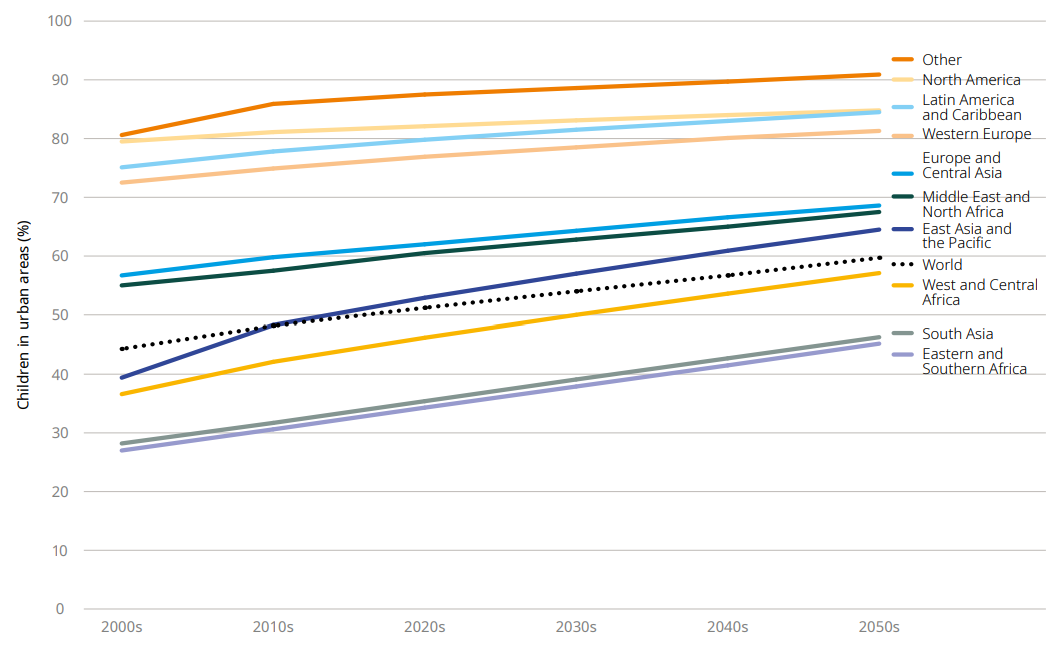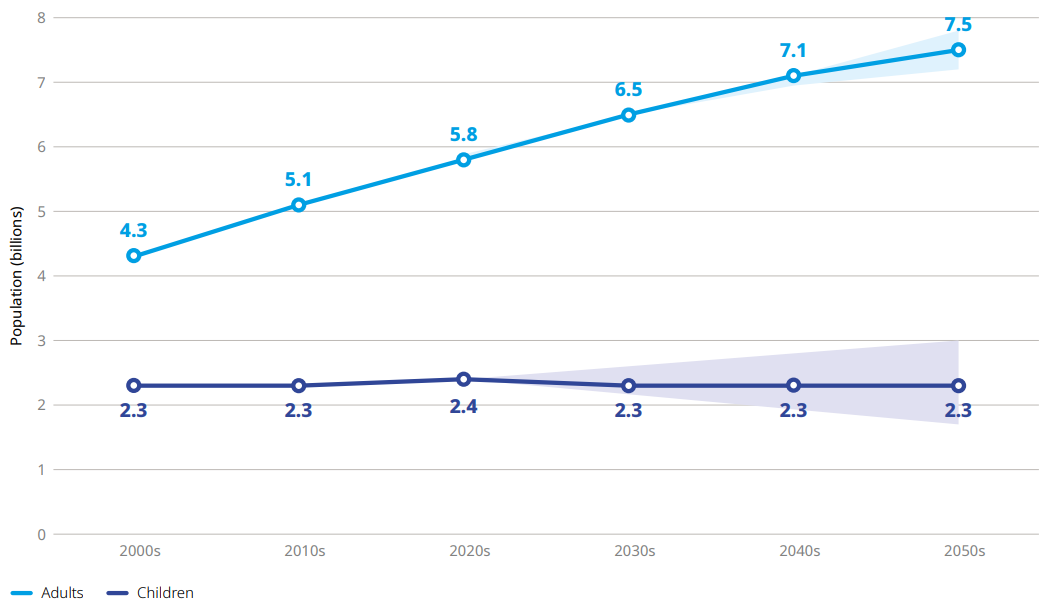Social Justice
The State of the World's Children 2024
- 21 Nov 2024
- 10 min read
For Prelims: United Nations International Children's Emergency Fund (UNICEF), World’s Children 2024, mRNA Vaccine, Children’s Climate Risk Index (CCRI) 2021, Mission LIFE, the National Action Plan on Climate Change, Swachh Bharat Mission, Jal Jeevan Mission, The Convention on the Rights of the Child, 1989, United Nations, Nobel Prize for Peace, SDGs, National Adaptation Plans, Nationally Determined Contributions.
For Mains: Sustainable development of children and climate change.
Why in News?
Recently, the United Nations International Children's Emergency Fund (UNICEF) released the State of the World’s Children 2024 (SOWC 2024) report that examines the forces and trends shaping children’ future by 2050.
- The report highlights three megatrends shaping children's lives by 2050 i.e., demographic shifts, climate crises, and frontier technologies.
What are the Key Findings of the SOWC 2024 Report?
- Child survival: Global newborn survival rates stand at over 98%, while the likelihood of a child surviving to age 5 stands at 99.5%.
- Life expectancy increases from 70 years for girls and 66 for boys born in the 2000s, to 81 years and 76 years, respectively.
- Climate Hazards: Children are projected to be exposed to extreme weather events at significantly higher rates: 8 times more to heatwaves, 3.1 times more to river floods, 1.7 times more to wildfires, 1.3 times more to droughts, and 1.2 times more to tropical cyclones.
- Socioeconomic conditions: 23% of the world’s children are projected to live in the 28 countries currently classified as low-income, more than double the share in these countries in the 2000s (11%).
- Education:
- The global education gap between girls and boys is expected to narrow, with more girls completing upper secondary education in some regions.
- Gender Equality: By the 2050s, gender inequality is expected to reduce in children's lives globally.
- However, many children are projected to live with high gender inequality in Eastern and Southern Africa and West and Central Africa.
- Conflict Exposure: The number of children living in conflict-prone areas is projected to drop from more than 833 million in the 2000s to 622 million in the 2050s.
- Urbanisation: Nearly 60% of children globally are projected to live in urban areas in the 2050s, up from 44% in the 2000s.
What are the Megatrends that are Shaping Children's Lives?
- Demographic Shift: By 2050, the global child population is expected to stabilise at 2.3 billion. Child populations will grow in South Asia, Eastern and Southern Africa, and West and Central Africa.
- Africa's child population share is expected to fall below 40% (from 50% in the 2000s), while it will drop below 19% in East Asia, Western Europe, and North America.
- Climate Crisis: Nearly 1 billion children live in countries with high exposure to climate hazards, such as pollution, extreme weather, and biodiversity loss.
- Children's developing bodies are particularly vulnerable to pollution and extreme weather, with their brains, lungs, and immune systems at risk even before birth.
- Since 2022, 400 million students around the world have experienced school closures due to extreme weather.
- Frontier Technologies: Artificial intelligence (AI), neurotechnology, next-generation renewable energy and mRNA vaccine breakthroughs could significantly improve childhood in the future.
- However, While over 95% of people in high-income countries are internet-connected, only 26% in low-income countries have access.
What are India-Specific Findings of the SOWC 2024 Report?
- Child Population: By 2050, India is expected to have the largest child population, with about 350 million children, making up 15% of the global total.
- India, China, Nigeria and Pakistan together are expected to account for more than a third of the world’s population of children by 2050.
- Climate Risks: India ranks 26th out of 163 countries on the Children’s Climate Risk Index (CCRI) 2021, reflecting high exposure to climate-related hazards.
- Indian children face significant risks from extreme heat, floods, droughts, and air pollution.
- CCRI is released by UNICEF that ranks countries based on children's exposure to climate shocks like cyclones and heatwaves, and their vulnerability due to access to essential services.
Note:
UNICEF has been collaborating with the government of India for the past 75 years, and in 1992, India ratified The Convention on the Rights of the Child, 1989.
- The United Nations Convention on the Rights of the Child was adopted in 1989 to protect and fulfil children’ rights.
UNICEF
- About: UNICEF is a leading global organisation that works to ensure that every child survives, thrives, and fulfils their potential, regardless of their background or where they live.
- UNICEF's work is impartial, non-political, and neutral and it operates in over 190 countries and territories.
- Establishment: It was established in 1946 in the aftermath of World War II to help children whose lives and futures were at risk – no matter what role their country had played in the war.
- UNICEF became a permanent part of the United Nations in 1953.
- Core Activities: Education, health, and nutrition, Child protection, Clean water and sanitation and Climate change and disease.
- UNICEF is guided by the Convention on the Rights of the Child, 1989.
- Recognition: It was awarded the Nobel Prize for Peace in 1965 for “promotion of brotherhood among the nations”.
- Strategic Plan (2022–2025): It drives coordinated efforts for an inclusive Covid-19 recovery, faster progress toward the SDGs, and a society where every child is included, empowered, and has their rights fulfilled.
How to Secure Children’ Future as per the SOWC 2024 Report?
- Prepare for Demographic Transitions: Ensure access to maternal, newborn, child and adolescent healthcare, along with sexual and reproductive health and family planning services.
- Create child-friendly cities with safe spaces, infrastructure, and support for marginalised children, including those with disabilities.
- Invest in Climate, Mitigation and Education: Ensure children’s needs are addressed in National Adaptation Plans, Nationally Determined Contributions and other climate strategies.
- Integrate climate resilience into local planning, including schools, healthcare, social services, and water and sanitation.
- Connectivity and Safe Design: Promote digital literacy and skills among children and educators to complement traditional teaching.
- Implement rights-based governance for new technologies, with oversight mechanisms to anticipate risks.
Conclusion
The UNICEF State of the World’s Children 2024 report emphasises the need for proactive planning and climate adaptation to secure a sustainable future for children. Ensuring access to healthcare, education, and digital opportunities, while addressing environmental risks, is essential to protect children’s rights and promote their well-being globally.
|
Drishti Mains Question: Discuss the impact of climate change on children’s future, especially in India, and the role of government initiatives in mitigating these risks. |
UPSC Civil Services Examination, Previous Year Question (PYQ)
Prelims
Q. With reference to the United Nations Convention on the Rights of the Child, consider the following: (2010)
- The Right to Development
- The Right to Expression
- The Right to Recreation
Which of the above is/are the Rights of the child?
(a) 1 only
(b) 1 and 3 only
(c) 2 and 3 only
(d) 1, 2 and 3
Ans: (d)
Mains
Q. Hunger and Poverty are the biggest challenges for good governance in India still today. Evaluate how far successive governments have progressed in dealing with these humongous problems. Suggest measures for improvement. (2017)
Q. Examine the main provisions of the National Child Policy and throw light on the status of its implementation. (2016)








